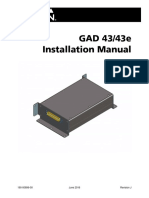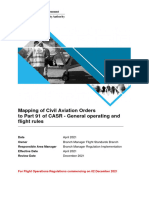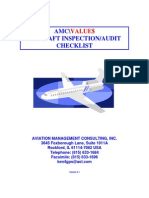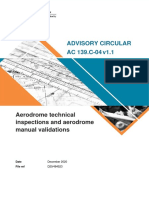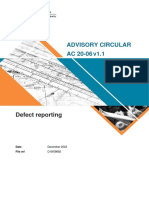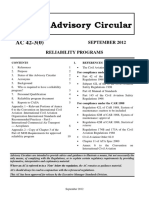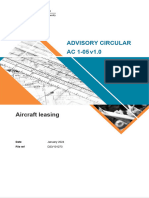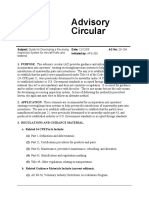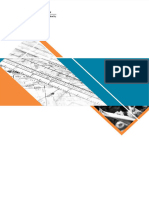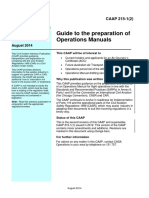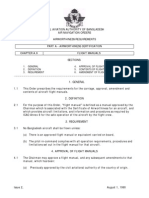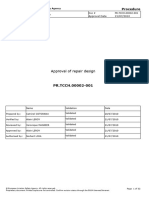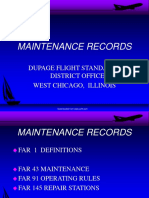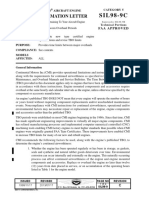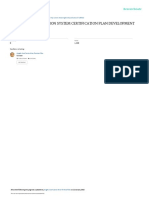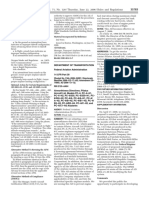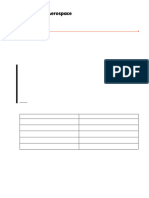Draft Ac20 03 v1
Draft Ac20 03 v1
Uploaded by
FebrianRezaHermawanCopyright:
Available Formats
Draft Ac20 03 v1
Draft Ac20 03 v1
Uploaded by
FebrianRezaHermawanOriginal Description:
Original Title
Copyright
Available Formats
Share this document
Did you find this document useful?
Is this content inappropriate?
Copyright:
Available Formats
Draft Ac20 03 v1
Draft Ac20 03 v1
Uploaded by
FebrianRezaHermawanCopyright:
Available Formats
DRAFT
ADVISORY CIRCULAR
AC 20-03
Identification and management of
aeronautical products
v1.0 – January 2016
IDENTIFICATION AND MANAGEMENT OF AERONAUTICAL PRODUCTS
Advisory Circulars are intended to provide advice and guidance to illustrate a means, but not necessarily the only
means, of complying with the Regulations, or to explain certain regulatory requirements by providing informative,
interpretative and explanatory material.
Advisory Circulars should always be read in conjunction with the relevant regulations.
Audience
This Advisory Circular (AC) applies to:
• Subpart 21.G - Production Certificate Holders
• Part 42 Continuous Airworthiness Management Organisations
• Part 145 Aircraft Maintenance Organisations
• Part 30 of Civil Aviation Regulations 1988 (CAR) - Certificates of Approval holders for
maintenance or distribution
• operators and maintainers.
Purpose
The purpose of this AC is to provide guidance to the aviation community for identification of aircraft
and aeronautical products.
For further information
For further information on this AC, contact Civil Aviation Safety Authority's (CASA’s) Airworthiness
and Engineering Standards Branch (telephone 131 757).
Status
This version of the AC is approved by the Executive Manager, Standards Division.
Version Date Details
1.0 Initial version. Aeronautical product information published within Civil Aviation
Advisory Publication (CAAP) 51-2, CAAP 42W-1 and other related
airworthiness ACs was reviewed and updated for inclusion within this AC.
Whilst previously drafted under AC 21Q, CASA has determined that the
contents apply to a wider set of regulations than under subpart 21Q of CASR
and thus the generic 20 series numbering has now been utilised.
Unless specified otherwise, all subregulations, regulations, divisions, subparts and parts
referenced in this AC are references to the Civil Aviation Safety Regulations 1998 (CASR).
DRAFT AC 20-03 v1.0 January 2016 Page 1
IDENTIFICATION AND MANAGEMENT OF AERONAUTICAL PRODUCTS
Contents
1 Reference material 3
1.1 Acronyms 3
1.2 Definitions 4
1.3 References 5
2 Background 8
2.1 Aeronautical product and aircraft component 8
2.2 Approved design 9
2.3 Identification of parts 10
2.4 Approved parts and unapproved parts 12
2.5 Unserviceable parts 13
2.6 Unsalvageable parts 14
3 Detection of unapproved parts 16
3.2 Part records 16
3.3 Procurement process 16
3.4 Acceptance procedures 17
3.5 Supplier evaluations 18
4 Reports 19
4.1 Unapproved parts 19
4.2 Reporting major defects 19
4.3 Reporting to CASA 19
4.4 Reporting to other approval holders 20
5 Salvaging parts 21
6 Disposal of parts 22
DRAFT AC 20-03 v1.0 January 2016 Page 2
IDENTIFICATION AND MANAGEMENT OF AERONAUTICAL PRODUCTS
1 Reference material
1.1 Acronyms
The acronyms and abbreviations used in this AC are listed in the table below.
Acronym Description
AC Advisory Circular
AD Airworthiness Directive
AMO Aircraft Maintenance Organisation
APMA Australian Parts Manufacturer Approval
ARC Authorised Release Certificate
ATSO Australian Technical Standard Order
CAAP Civil Aviation Advisory Publication
CAO Civil Aviation Order
CAR Civil Aviation Regulations 1988
CASA Civil Aviation Safety Authority
CASR Civil Aviation Safety Regulations 1998
COTS Commercial Off The Shelf
ETSO European Technical Standard Order
FAA Federal Aviation Administration (of the United States of America)
FITCOM Fabrication In The Course Of Maintenance
ICAO International Civil Aviation Organization
MITCOM Manufacture In The Course Of Maintenance
NAA National Airworthiness Authority
PMA Parts Manufacturer Approval (FAA)
SUP Suspected Unapproved Part
STC Supplemental Type Certificate
TC Type Certificate
TSO Technical Standard Order (FAA)
DRAFT AC 20-03 v1.0 January 2016 Page 3
IDENTIFICATION AND MANAGEMENT OF AERONAUTICAL PRODUCTS
1.2 Definitions
Terms that have specific meaning within this AC are defined in the table below.
Term Definition
Aeronautical Product Any part or material that is, or is intended by its manufacturer, to be a part of
or used in an aircraft, unless excluded by the regulations - see Part I of the
Civil Aviation Act 1988 (the Act).
Aircraft Component Any part or equipment for an aircraft that, when fitted to, or provided in an
aircraft may, if it is not sound or functioning correctly, affect the safety of the
aircraft, its occupants or its cargo or cause the aircraft to become a danger to
person or property or flotation equipment, evacuation equipment, ration
packs, portable breathing apparatus, fire-fighting equipment, or any other
equipment or apparatus, fitted to, or provided in, an aircraft for use in an
emergency - see Part 1 of the CASR Dictionary.
Aircraft Material Material (including a fluid) for use in the manufacture, maintenance, servicing
or operation of an aircraft or of an aircraft component, but does not include an
aircraft component - see Part 1 of the CASR Dictionary.
Approved Design For an aeronautical product, other than an aircraft engine or propeller, that is
approved in a manner mentioned in regulation 21.305 or 21.305A, the design
specifications for the product and any changes to the design specifications
made in accordance with a Part 21 approval.
Certificate of Terminology used to describe a certificate issued by the manufacturer of a
Conformance standard part, stating that the part conforms to a stated industry standard or
Specification.
Class I Product Includes a complete aircraft, aircraft engine or propeller for which a foreign
type certificate has been issued - see paragraph 21.321 (2) (a).
Class II Product A major component of a Class I product, the failure of which would jeopardise
the safety of a Class I product - see paragraph 21.321 (2) (b).
Class III Product Any part or component which is not Class I or Class II product and includes
standard parts - see paragraph 21.321 (2) (c).
Critical Part A part that must be inspected, overhauled, or removed or retired from the
aircraft within a period specified in the Airworthiness Limitations section of the
Manufacturer’s Maintenance Manual (as published from time to time by the
aircraft’s manufacturer) for the aircraft or in the Manufacturer’s Instructions for
Continued Airworthiness (as published by the manufacturer from time to time)
for the aircraft.
Distributor Brokers suppliers, resellers, or other individuals and agencies engaged in the
sale of aircraft parts.
Instructions for Written instructions for an aircraft or aeronautical product as per Clause 10 of
Continued Airworthiness Part 3 of the CASR Dictionary.
Part For this purpose of this AC a part refers to any aeronautical product, aircraft
component, product or appliance.
Standard Part A part that complies with a specification that is established, published and
maintained by an organisation that sets consensus standards for products or
a government agency and includes design, manufacturing, test and
acceptance criteria and requirements for the uniform identification of the part -
see Part 1 of the CASR Dictionary.
DRAFT AC 20-03 v1.0 January 2016 Page 4
IDENTIFICATION AND MANAGEMENT OF AERONAUTICAL PRODUCTS
Term Definition
Serviceable An aeronautical product is serviceable if the product conforms with its
approved design and is fit for its intended use - see subregulation 42.015 (6).
Time-lifed component An aircraft component (including an engine or propeller) that the
manufacturer of the component or if the component has been modified—the
designer of the modification or CASA has instructed must be retired or
overhauled or removed from an aircraft within a particular period.
Unsalvageable An aeronautical product is unsalvageable if the product is unserviceable and
cannot be made serviceable - see subregulation 42.015 (7).
1.3 References
Regulations
Regulations are available on the ComLaw website http://www.comlaw.gov.au/Home
Document Title
Civil Aviation Act 1988 (the Act)
Subpart 21.Q Identification of aircraft and aeronautical products
Subpart 21.K Approval of materials, parts, processes and appliances
Subpart 21.O Australian Technical Standard Order Authorisation
Subpart 42.E Aeronautical products
CASR Dictionary
Part 42 Manual of
standards (MOS)
Part 145 MOS
Part 4A of CAR Maintenance
Part 4D of CAR Removal of data plates and registration identification plates
Regulation 30 Certificates of approval
of CAR
Regulation 42W Installation and use of aircraft components in maintenance - Australian
of CAR aircraft in Australian territory
Regulation 42ZA Use of aircraft components, aircraft materials etc. in maintenance - Australian
of CAR aircraft outside of Australian territory
Regulation 42W Installation and use of aircraft components in maintenance—Australian
of CAR aircraft in Australian territory
Regulation 42WA Requirements for authorised release certificate
of CAR
Regulation 42ZP Certification not to be made
of CAR
DRAFT AC 20-03 v1.0 January 2016 Page 5
IDENTIFICATION AND MANAGEMENT OF AERONAUTICAL PRODUCTS
Document Title
Regulation 42ZQ Related document - issued by manufacturer of an aircraft component or
of CAR aircraft material
Regulation 47 of CAR Maintenance release to cease to be in force
Regulation 50E of CAR Inconsistent requirements - resolution of inconsistencies
Regulation 51A of CAR Reporting of defects in Australian aircraft—general
Regulation 52 of CAR Defects discovered in aircraft components
Regulation 52A of CAR How must reports to Authority be made?
Regulation 52B of CAR Keeping of defective aircraft and aircraft components
Regulation 53 of CAR Investigation of defects of Australian aircraft
Civil Aviation Order Aircraft equipment — basic operational requirements
(CAO) 20.18
CAO 100.5 General requirements in respect of maintenance of Australian aircraft
CAO 100.16 Administration Procedure - distribution & rejection of aircraft components and
materials
Advisory material
Advisory Circulars are available at http://www.casa.gov.au/AC
Acceptable Means of Compliance and Guidance Material (AMC/GM) are available at http://www.casa.gov.au/amcgm
Civil Aviation Advisory Publications are available at http://www.casa.gov.au/CAAP
Airworthiness Bulletins are available at https://www.casa.gov.au/airworthiness/AWB
Document Title
AC 21-08 Approval of modification and repair designs under Subpart 21.M
AC 21-14 Production Certificates
AC 21-16 Approval of Materials, Parts, Processes and Appliances
AC 21-17 Export Airworthiness Approvals
AC 21-22 Approval of Imported Engines, Propellers, Materials, Parts and Appliances
AC 21-601 Australian Technical Standard Order Authorisation
AC 45-01 Nationality and Registration Marks
AMC/GM Part 42 Continuing airworthiness requirements for aircraft and aeronautical products
AMC/GM Part 145 Approved maintenance organisation requirements
CAAP 30-4 Certificate of Approval – Maintenance Organisation
CAAP 37-1 Minimum equipment lists (MEL)
CAAP 42W-1 Documents for the supply of aircraft components and materials
CAAP 42W-2 Authorised Release Certificate
DRAFT AC 20-03 v1.0 January 2016 Page 6
IDENTIFICATION AND MANAGEMENT OF AERONAUTICAL PRODUCTS
Document Title
CAAP 51-1 Defect reporting
CAAP 51-2 Detecting and reporting suspected unapproved parts
AWB General Advice 01 Suspected Unapproved Parts - Notifications
Other references
Document Title
Annex 8, Airworthiness of Annex 8, Airworthiness of Aircraft to the Convention on International Civil
Aircraft to the Chicago Aviation (the Chicago Convention)
Convention
ICAO Doc 9760 Airworthiness Manual
ICAO Circular 95 The Continuing Airworthiness of Aircraft in Service
FAA Unapproved Parts
Notifications (UPN)
FAA AC 21-29C Detecting and Reporting Suspected Unapproved Parts
Forms
CASA’s forms are available at http://www.casa.gov.au/forms
Form number Title
Form 1 Authorised Release Certificate
Form 1i Authorised Release Certificate - Instructions for completion by the originator
Form 724 Statement of Conformity
Form 1058 Suspected Unapproved Parts Report
DRAFT AC 20-03 v1.0 January 2016 Page 7
IDENTIFICATION AND MANAGEMENT OF AERONAUTICAL PRODUCTS
2 Background
2.1 Aeronautical product and aircraft component
Figure 1 displays the relationship between an aeronautical product, component and part
depending on applicable regulation. The paragraphs that follow describe these in detail.
Figure 1: Relationship between aeronautical product and aircraft component or part
Aeronautical product
2.1.1 Section 3 of the Civil Aviation Act 1988 (the Act) defines an aeronautical product as any
part or material that is, or is intended by its manufacturer to be, a part of or used in an
aircraft, unless it is excluded by the regulations. Aeronautical product also covers
equipment that does not come with an Authorised Release Certificate (ARC), but is
intended for use in an aircraft—for example, night vision equipment.
DRAFT AC 20-03 v1.0 January 2016 Page 8
IDENTIFICATION AND MANAGEMENT OF AERONAUTICAL PRODUCTS
2.1.2 Parts, materials, standard parts, components, appliances and equipment are all
aeronautical products under the Act, unless excluded in a legislative instrument under
subclause 1 (2) of Part 2 of the CASR Dictionary. Examples of parts excluded as
aircraft components are headsets and night vision goggles.
Aircraft component
2.1.3 Part 1 of CAR provides the interpretation for an aircraft component in which the part or
component may affect the safety of the aircraft, or is classified as emergency
equipment. Aircraft components are required to have an ARC before installation.
Approval of materials, parts, processes and appliances
2.1.4 Regulation 21.305 provides different approval methods for parts. Regulation 21.305A
provides an alternative approval method, whenever a part has not been approved
during standard certification and production approvals.
Authorised Release Certificate
2.1.5 The ARC is a certificate of release to service for an aeronautical product that declares
its serviceability. The ARC does not constitute approval to install the item on a particular
aircraft or aeronautical product, but helps the end-user determine its airworthiness
approval status.
2.1.6 ARCs are also issued by manufacturers under Part 21 or by Aircraft Maintenance
Organisations (AMO).
Installation or fitment
2.1.7 For aircraft operating under Part 42, Table 12.3.1 of the Part 42 MOS details which
foreign countries' ARCs are accepted and also provides details on rejecting a defective
part. For further details on details on completing an ARC see CASA Form 1i.
2.1.8 For aircraft operating under the CAR, Appendix 1 of CAO 100.16 contains a table of
appropriate documents for use as an ARC. For further details regarding the ARC see
CAAP 42W-2.
2.1.9 If the components are accompanied by the correct documentation, subsequent
installation of these aircraft components is allowed, depending on whether the
regulations of the CAR or CASR apply. The following regulations specify requirements:
− regulations 42W and 42ZA of the CAR
− regulation 42.420.
2.2 Approved design
2.2.1 The approved design for an aeronautical product is conducted under regulation 21.305
or 21.305A, and includes the design specifications for the part and any changes in
accordance with Part 21 approval.
2.2.2 Parts or materials not detailed in the approved design are ineligible for fitment.
DRAFT AC 20-03 v1.0 January 2016 Page 9
IDENTIFICATION AND MANAGEMENT OF AERONAUTICAL PRODUCTS
2.3 Identification of parts
2.3.1 As per regulation 21.321, parts are identified by 3 different product classes. The
documentation required to accompany a part is dependent on the product class. For
example, in the case in Figure 2, the Class I product is a type certified engine. The
engine has a Class II generator installed and the generator has Class III products such
as terminal blocks and fasteners. Depending on the approved design, some Class II
products may have other Class II products fitted to them as a sub assembly.
Figure 2: Classes of products
2.3.2 Class I products
2.3.2.1 Class I products are complete aircraft, aircraft engines or propellers that are type-
certified. Class I products are identified by a manufacturers data plate or identification
marks. Type-certified products are regulated under Division 21.Q.2 and require CASA's
written approval (as per Part 45 of CASR or Part 4D of CAR) to remove manufacturer's
data plates. It is acceptable to remove the plate in order to carry out maintenance
followed by re-installation of the plate.
Note: For further information on removal of the manufacturer's data plates see CASA AC 45-01.
2.3.2.2 The manufacturer's data plate is important for maintaining configuration, Airworthiness
Directive (AD) compliance, overhaul, life-limited parts, module changes and compliance
throughout the entire service life.
2.3.2.3 The manufacturer's data plate serves as the baseline to control all maintenance activity
accomplished. There is a concern that removal of data plates, other than for
maintenance action, may cause loss of traceability to the originally type-certified
product.
2.3.3 Class II products
2.3.3.1 Class II products are major components of a Class I products, the failure of which would
jeopardise the safety of the Class I product. Class II products are approved under
regulation 21.305 and 21.305A, and are usually serialised (see Figure 3).
Note: If an item is required to be approved for any airworthiness or operational purposes, it can only be
approved under regulation 21.305.
DRAFT AC 20-03 v1.0 January 2016 Page 10
IDENTIFICATION AND MANAGEMENT OF AERONAUTICAL PRODUCTS
2.3.3.2 An Australian Technical Standard Order (ATSO) is a minimum performance standard
issued by CASA. ATSO markings are only allowed if an article meets the applicable
performance standard as per regulation 21.603. ATSO articles require the following
information:
− name and address of the manufacturer
− name, type, part number or model designation of the article
− serial number or date of manufacture of the article or both
− applicable ATSO, Federal Aviation Administration (FAA) TSO or European
Technical Standard Order (ETSO) number with the prefix ATSO. 1
2.3.3.3 An Australian Parts Manufacturing Approval (APMA) covers approval for parts that are
modifications or replacement parts. They are required to have the letters 'APMA' in front
of the part number. If the part is identical it may use the same number as the original
part and it has a prefix to identify the manufacturer. 2
2.3.4 Class III products
2.3.4.1 Class III products are any parts or components that are not Class I or II, and include
standard parts. A Class III product is eligible for installation on a Class I or II product if it
is listed in the approved design. Materials that are not specified in the approved design
are ineligible for use. An approval process under Part 21 can approve alternate Class III
products, if not they detailed in the approved design.
2.3.4.2 Standard parts are supplied with a document issued under the law of an International
Civil Aviation Organization (ICAO) contracting state and contain a statement that
identifies the standard parts and the specification with which the part complies-for
example, Army-Navy specification, National Aerospace or with SAE International.
2.3.4.3 Class III products can include commercial off-the-shelf (COTS) parts. 3
2.3.5 Critical parts
2.3.5.1 Critical parts are those that must be inspected, overhauled, removed or retired within a
specific time period. This period is specified in the airworthiness limitations section of
the manufacturer's maintenance manual or the manufacturer's instructions for continued
airworthiness.
2.3.5.2 Critical parts require part number and serial number information to be marked in a way
that ensures it is not likely to be defaced.
2.3.6 Aircraft materials
2.3.6.1 Aircraft materials are used in product Classes I, II and III. An aircraft material is any
material, including fluids, for use in the manufacture, maintenance, servicing or
operation of an aircraft or aircraft component. Aircraft materials are approved under
regulations 21.305 or 21.305A.
2.3.6.2 Aircraft materials are required to meet the type design of the type-certified product or
approved design of the part under regulation 21.306. Materials that are not specified in
1
For further information on ATSOs see AC 21-601.
2
For further information on APMAs see AC 21-16.
3
For further information on use of COTS parts see Appendix C of AC 21-08.
DRAFT AC 20-03 v1.0 January 2016 Page 11
IDENTIFICATION AND MANAGEMENT OF AERONAUTICAL PRODUCTS
the approved design are ineligible for use. An approval under Subpart 21.M can
approve alternate materials if not detailed in the approved design.
2.3.6.3 Materials are required to have a document that was issued under the law of a
contracting state, which contains a statement that identifies the material and
specification. 4
2.3.7 MITCOM/FITCOM
2.3.7.1 Manufacture in the course of maintenance (MITCOM) applies to maintenance
organisations holding an approval under regulation 30 of CAR and aircraft being
maintained under Part 4 or Part 4A of CAR.
2.3.7.2 Fabrication in the course of maintenance (FITCOM) applies to maintenance
organisations holding an approval under Part 145 or the aircraft is being maintained
under Part 42.
2.3.7.3 FITCOM/MITCOM is usually for Class III products that are used on an aircraft on which
a maintenance organisation is carrying out maintenance. They are ineligible for sale or
issue of an ARC.
2.3.7.4 There is a requirement to mark MITCOM parts using the original manufacturer's part
number and the identification that clearly relates to the organisation's identity and
manufacturing/inspection data. FITCOM parts require a part number that clearly relates
to the manufacturing/inspection data and the organisation's identity on the part for
traceability purposes. Parts that are considered too small for marking can use a tag for
identification prior to fitment. 5
2.4 Approved parts and unapproved parts
2.4.1 Whenever a part is required to be approved by CASA, it is approved under
regulation 21.305. For example, if equipment is installed for ASETPA 6, TBO 7
extensions, or emergency equipment that equipment will require approval. Figure 3
provides a flowchart that will assist the reader in determining eligibility for aeronautical
product fitment.
2.4.2 The approved data will specify the eligibility of approved parts for a specific installation.
Not all service bulletins are mandatory unless required by an airworthiness directive;
however, it is recommended they are considered for any potential impacts. Parts such
as military specification parts are acceptable if they are detailed in the approved design.
2.4.3 Unapproved parts have a specific meaning under regulation 42.470. This regulation
covers intentional misrepresentation, modifications outside of Part 21 approvals and
unauthorised maintenance.
2.4.4 For aircraft operating under the CAR, Parts 42W and 42ZA of CAR do not describe the
term for an unapproved part. These regulations describe the eligibility of a part and
requirements for its intended installation.
4
For further information on using materials see GM 42.455(1) (a) for those aircraft and components
maintained by a Part 145 organisation.
5
For further information see CAAP 30-4 for MITCOM parts and the AMC/GM Part 145 for FITCOM parts.
6
Approved single engine turbine powered aircraft.
7
Time between overhaul.
DRAFT AC 20-03 v1.0 January 2016 Page 12
IDENTIFICATION AND MANAGEMENT OF AERONAUTICAL PRODUCTS
2.4.5 Suspected unapproved part
2.4.5.1 The term 'suspected unapproved part' (SUP) has been used to describe parts of
unknown status or insufficient information at the time of discovery. It is suspected of not
meeting the requirements for approved part and is a temporary status until verified as
unapproved or serviceable.
2.4.5.2 A manufacturing or maintenance error may be the cause of the problem, in which case
the part may be re-eligible for use after further verification, maintenance or modification
(see Figure 3). Some generally used aviation terms are not defined under the CAR (e.g.
there is no definition for 'unsalvageable' or 'unserviceable'). However the methods
described in the CASR may be relevant to all parts, irrespective of which legislative
scheme they are covered under (e.g. dealing with parts when they are no longer
considered serviceable).
2.4.5.3 An approved part used in the wrong application is not an unapproved part. This can
represent failure to follow the approved design and ICA. Parts that are damaged due to
shipping or warranty issues are not unapproved parts.
2.4.5.4 For further information on SUPs see:
− CASA Airworthiness Bulletin General Advice 01: suspected unapproved parts -
notifications
− FAA unapproved parts notifications.
2.4.5.5 CASA encourages reporting of any unapproved and SUPs via the CASA SDR system.
2.5 Unserviceable parts
2.5.1 A serviceable part, as defined in regulation 42.015, is a part that conforms to its
approved design and is fit for its intended purpose (see Figure 3). The maintenance
engineer installing the part may suspect, for some reason, that a part is not fit for its
intended purpose, therefore warranting further investigation.
2.5.2 Paragraph 10 of CAO 20.18 details the requirements for serviceability of parts and
equipment. Appendices in the CAO specify the required instruments depending on the
category of flight.
2.5.3 Minimum equipment lists or permissible unserviceabilities do not automatically allow
operations with equipment removed. Improper removal of equipment may have adverse
effects on aircraft weight and balance, or operations of other critical systems. Removal
of equipment outside the approved data will require additional approvals. 8
2.5.4 The requirements in the regulations for serviceable components are in either:
− regulations 42W and 42ZA of the CAR
− regulation 42.420. 9
8
For further information see CAAP 37-1.
9
For further information on current airworthiness related unserviceabilities see CASA's Airworthiness
Bulletins series.
DRAFT AC 20-03 v1.0 January 2016 Page 13
IDENTIFICATION AND MANAGEMENT OF AERONAUTICAL PRODUCTS
2.6 Unsalvageable parts
2.6.1 An aeronautical product is unsalvageable if it is unserviceable and all attempts at
maintenance cannot bring the part back to a serviceable state. Regulation 42.465 states
the requirements for unsalvageable parts (see Figure 3). These regulations also apply if
a registered operator voluntarily uses the aircraft maintenance services of a Part 145
AMO in lieu of maintenance services provided by a Certificate of Approval holder under
regulation 30 of CAR.
2.6.2 For aircraft maintained under Part 4A of CAR, regulation 42W or 42ZA of CAR requires
components to be un-damaged and in compliance with the manufacturer's
specifications. The maintenance release for the aircraft ceases to be in force under
regulation 47 of CAR if there is a major defect other than a permissible unserviceability.
DRAFT AC 20-03 v1.0 January 2016 Page 14
IDENTIFICATION AND MANAGEMENT OF AERONAUTICAL PRODUCTS
Figure 3: Component life cycle
DRAFT AC 20-03 v1.0 January 2016 Page 15
IDENTIFICATION AND MANAGEMENT OF AERONAUTICAL PRODUCTS
3 Detection of unapproved parts
3.1 General
3.1.1 Positive identification of unapproved parts is often difficult, due to the similarity of
unapproved part’s characteristics. Some of the issues may not appear visually.
3.1.2 Reasons for suspecting that a part is unapproved can include: 10
− different finish
− size
− colour
− improper identification
− incomplete or altered paperwork
− parts that do not conform to the approved design
− modifications on an aircraft or component that have not been approved
− parts that have not been passed through an approved quality system
− parts which cannot be traced to their original source
− parts maintained to superseded approved designs
− not following the relevant approved design
− parts maintained by facilities that are not authorised
− intentional misrepresentation
− any questionable identification.
3.2 Part records
3.2.1 Legibility of records or accuracy of electronic data storage is important for showing
compliance with ADs and other mandatory requirements. If records for parts are unable
to be read properly or a replacement obtained, they are assumed as incomplete.
3.2.2 Depending on the application, the requirements for records are detailed in:
− Part 4A of CAR and CAO 100.5
− regulation 42.260.
3.3 Procurement process
3.3.1 A procedure to prevent procurement of unapproved parts should be established prior to
purchasing parts and materials for installation in type-certificated products.
3.3.2 This procedure should include the following elements as a minimum:
− methods to establish qualified suppliers who are authorised to manufacture and/or
distribute parts they supply
− criteria to identify and screen potential suppliers of unapproved parts. The criteria
should include the following considerations:
o the quoted price or the price advertised in trade magazines is significantly
lower than the price quoted by other suppliers of the same part
10
FAA AC 21-29C has further information on detecting unapproved parts.
DRAFT AC 20-03 v1.0 January 2016 Page 16
IDENTIFICATION AND MANAGEMENT OF AERONAUTICAL PRODUCTS
o a delivery schedule that is significantly shorter than that of other suppliers of
the same part when existing stocks are exhausted
o the inability of a supplier to provide drawings, specifications, overhaul manuals,
or substantiating data demonstrating the conformity of the part’s
repair/overhaul
o a distributor and/or supplier’s inability or unwillingness to provide substantiating
documentation that the part was produced pursuant to a National Airworthiness
Authority's (NAA’s) approval, or inspected, repaired, overhauled, preserved or
modified in accordance with the regulations
o sales quotes or discussions that create the perception that unlimited supplies
of parts, components, or material are available to the end-user.
3.4 Acceptance procedures
3.4.1 Acceptance procedures should include a means of identifying possible unapproved
parts during the receiving inspection so as to prevent their acceptance. Part 145
organisations are required to detail acceptance procedures for aeronautical products
into their exposition (see AMC/GM Part 145 for further detail). 11
3.4.2 The following suggested actions are provided as a guide:
− confirm the packaging of the part identifies the supplier or distributor, and is free
from alteration or damage
− verify that the actual part and delivery receipt reflect the same information as the
purchase order regarding part number, serial number, and historical information (if
applicable)
− verify that the identification on the part has not been tampered with, for example:
o serial number stamped over
o label or part/serial numbers improper or missing
o etched or serial numbers located at other than the normal location
− ensure that the shelf life and/or life limit has not expired (if applicable)
− conduct a visual inspection of the part and supporting documents to the extent
necessary to determine if the part is traceable to an NAA's approved source
− check appropriate markings (see section 2.3 of this AC)
− evaluate any visible irregularities, for example:
o altered or unusual surface
o absence of required plating
o evidence of prior usage
o scratches
o new paint over old
o attempted exterior repair
o pitting or corrosion
− conduct random sampling of standard hardware packaged in large quantities in a
manner which corresponds to the type and quantity of the parts
− quarantine parts of questionable nature and attempt to resolve issues regarding the
questionable status of each part (for example, obtain necessary documentation if
11
For acceptance procedures for Certificate of Approval holder under regulation 30 of CAR, see
CAAP 30-4.
DRAFT AC 20-03 v1.0 January 2016 Page 17
IDENTIFICATION AND MANAGEMENT OF AERONAUTICAL PRODUCTS
inadvertently not provided, or determine if irregularities are a result of shipping
damage and handle accordingly). 12
3.5 Supplier evaluations
3.5.1 Procedures to conduct audits of suppliers on a scheduled basis, to ensure that
suppliers have established and continue to maintain the quality system specified in
purchase orders should be developed. Parts obtained from outside of CASA oversight
or an NAA are not subject to surveillance. Part 145 organisations are required to detail
supplier evaluation procedures for aeronautical products into their exposition. 13
3.5.2 The following are examples of elements that should be included in an audit program:
− continued validity of NAA’s approval
− design data control, to include latest revision (if applicable)
− supplier control
− material handling/control
− manufacturing/assembly controls
− tool and gauge control
− tests and inspections
− records.
3.5.3 For aircraft materials from a CASA-approved distributor, any of the following would be
relevant:
− shipping invoices or orders showing traceability to heat treatment or lot of batch
numbers
− a certified true copy of the shipping invoice or order
− a certificate of conformance from the manufacturer
− statement that the original shipping invoice or order is held on file or is accessible
to the approved distributor
− other documentation such as the manufacturer's letter, which provides information
relating to the physical or chemical properties, traceable to heat or lot or batch
number.
3.5.4 For aircraft materials from other suppliers, the following would be relevant:
− manufacturer’s report showing the physical or chemical properties, traceable to
heat or lot or batch number
− certified true copy of such report
− certificate of conformance from the manufacturer.
12
For further information on acceptable foreign ARCs see the Part 42 MOS or CAO 100.16.
13
See AMC/GM Part 145 for further details. For supplier evaluations, see CAAP 30-4.
DRAFT AC 20-03 v1.0 January 2016 Page 18
IDENTIFICATION AND MANAGEMENT OF AERONAUTICAL PRODUCTS
4 Reports
4.1 Unapproved parts
4.1.1 An unapproved part could meet the definition of a major defect depending on the
criticality of failure. The CASR specifically deals with major defects of aeronautical
products. Major defects require reporting to CASA. 14
4.2 Reporting major defects
4.2.1 CAR
4.2.2 Regulation 51A of CAR defines a major defect in an aircraft, that has caused or could
cause:
− primary structural failure
− control system failure
− engine structural failure
− fire.
4.2.3 Regulation 51A of CAR requires any person who, while involved in the operation or
maintenance or an aircraft, discovers a major defect to report the defect to CASA
immediately.
4.2.4 Regulation 52 of CAR requires reporting to CASA if an aircraft component is found to
have a defect that, if the component were fitted to an aircraft, may affect the safety of
the aircraft or cause the aircraft to become a danger to persons or property.
4.2.5 CASR
4.2.6 The CASR Dictionary defines a major defect in an aeronautical product as one that, if it
is fitted to an aircraft, may affect the safety of the aircraft or cause the aircraft to
become a danger to persons or property.
4.2.7 The AMO is required to report major defects in an aeronautical product to CASA in
accordance with regulation 42.385.
4.2.8 Part 145 organisations are required to report occurrences and major defects for
aeronautical products. 15
4.3 Reporting to CASA
4.3.1 A completed CASA Form 1058 can be submitted electronically via the Internet to CASA.
14
See CAAP 51-1 for reporting of defects to CASA.
15
See AMC/GM Part 145 for further details.
DRAFT AC 20-03 v1.0 January 2016 Page 19
IDENTIFICATION AND MANAGEMENT OF AERONAUTICAL PRODUCTS
4.3.2 Reports can be mailed. free of charge from anywhere in Australia, to:
Civil Aviation Safety Authority
Reply Paid 2005
GPO Box 2005
CANBERRA CITY ACT 2601
Mark ‘IN-CONFIDENCE’ if confidentiality is required.
4.3.3 When confidentiality is not required, the completed SUP Report Form can be faxed to
(02) 6217 1920.
4.4 Reporting to other approval holders
4.4.1 Australia has an obligation under the Chicago Convention to report malfunctions,
failures, defects and other occurrences that might cause adverse effects on continuing
airworthiness to the type design organisation.
4.4.2 In addition to reporting major defects to CASA, there is a requirement to report to
holders of the following:
− type certificate
− supplemental type certificate (STC)
− APMA or FAA parts manufacturer approval (PMA)
− modification/repair design
− under any other relevant legislative instrument.
4.4.3 It is acceptable to use CASA Form 1058 to convey information on unapproved parts to
the type certificate holder or other entities.
4.4.4 Regulation 21.003 requires that holders of a type certificate, an STC, an APMA or
anATSO authorisation, or the licensee of a type certificate or STC, must report to CASA
any failure, malfunction or defect for any part or article that it has manufactured.
DRAFT AC 20-03 v1.0 January 2016 Page 20
IDENTIFICATION AND MANAGEMENT OF AERONAUTICAL PRODUCTS
5 Salvaging parts
5.1.1 Salvaged aircraft parts can lack maintenance history. Many of these aircraft parts have
been released to service after having been recovered from aircraft that may have been
involved in accidents or incidents. The accident or incidents may have caused
deterioration of the parts from any tolerances in the approved design. A part that has
suffered deterioration may not show any visual signs of damage, distortion or changed
characteristics; however, latent faults may be present.
5.1.2 The approved design may have insufficient detail to properly assess salvaged parts to
determine their serviceability. If the information in the approved design is insufficient to
assess the serviceability of potentially deteriorated salvaged components, consult the
Original Equipment Manufacturer for further guidance.
5.1.3 Depending on the design of the part, the complete functional operation of some
systems is able to be confirmed by testing in accordance with the approved design.
5.1.4 To maintain aircraft components that are salvaged, there should clear procedures
detailing the additional precautionary steps applicable to such parts.
5.1.5 CAR
5.1.5.1 Paragraph 42W (2) (c) of CAR allows for replacement of components as long as the
replacement component is not damaged and complies with its manufacturer's
specification. There is no ARC issued as a result, unless the component is
manufactured or repaired.
5.1.6 CASR
5.1.6.1 Regulation 42.430 allows for fitting parts removed from aircraft provided that
maintenance has not been carried out to either a different place on an aircraft or to
another aircraft.
5.1.6.2 The part can only be fitted to another aircraft or second aircraft if:
− the aircraft that the part was removed from is under a continued airworthiness
management program
− maintenance has not been carried out
− the part was stored and it was done in conjunction with instructions issued by the
manufacturer
− the part has not been immersed or exposed to extremes of stress or temperature
− the person responsible for continued airworthiness agrees to the fitting.
5.1.6.3 There is no ARC issued during the salvage process. ARCs are only issued for
component manufacture or maintenance (which includes repair).
DRAFT AC 20-03 v1.0 January 2016 Page 21
IDENTIFICATION AND MANAGEMENT OF AERONAUTICAL PRODUCTS
6 Disposal of parts
6.1.1 The CAR is not specific about the requirements for disposal of parts. However, parts
that are unserviceable are ineligible for fitment according to regulations 42W/42ZA of
CAR. The requirements set by Division 42.E.3 can be followed as they provide the
necessary outcomes. 16
6.1.2 Division 42.E.3 has requirements for controlling unserviceable and unsalvageable parts.
Once CASA has been notified of unapproved parts, and if they are not subject to further
action or if they are considered unsalvageable, they will be required to be any of the
following:
− stored separately and secured from serviceable aeronautical products
− returned to the owner
− scrapped, or have arrangements made for scrapping, so they cannot be installed
as a serviceable part. However, it is acceptable to use these parts as a training aid.
6.1.3 Contact CASA prior to scrapping any parts as they may be the subject of an
investigation.
16
For disposal of parts for Certificate of Approval holder under regulation 30 of CAR, see CAAP 30-4.
DRAFT AC 20-03 v1.0 January 2016 Page 22
You might also like
- Standard Practices Manual: Revision 7 1 OCTOBER 2019Document282 pagesStandard Practices Manual: Revision 7 1 OCTOBER 2019Vasiliy Terekhov100% (4)
- GAD43e IMDocument68 pagesGAD43e IMJoseeph Suazo Malpica100% (5)
- Old UAEMAR-21Document110 pagesOld UAEMAR-21Parush guptaNo ratings yet
- Mapping Civil Aviation Orders Part 91 Casr General Operating Flight RulesDocument24 pagesMapping Civil Aviation Orders Part 91 Casr General Operating Flight RulesHunt HangburNo ratings yet
- CAMP B737-345 MSG-2 Rev.40 PDFDocument631 pagesCAMP B737-345 MSG-2 Rev.40 PDFdark devil67% (3)
- ChecklistDocument14 pagesChecklistJoe Andrew100% (1)
- 020 C 03Document24 pages020 C 03slam12125No ratings yet
- Advisory Circular: DraftDocument24 pagesAdvisory Circular: Draftrichesh sharmaNo ratings yet
- Advisory Circular 21 34 Aircraft Flight ManualsDocument25 pagesAdvisory Circular 21 34 Aircraft Flight ManualsBen CharfiNo ratings yet
- Advisory Circular: AC 21-46 Airworthiness Approval of Avionics EquipmentDocument13 pagesAdvisory Circular: AC 21-46 Airworthiness Approval of Avionics EquipmentJNo ratings yet
- Caap 43 01 Maintenance ReleaseDocument18 pagesCaap 43 01 Maintenance ReleaseshishobNo ratings yet
- Advisory Circular 21 27 Manufacturing Approval OverviewDocument34 pagesAdvisory Circular 21 27 Manufacturing Approval Overviewtareksalah2097No ratings yet
- AC 21-11 Amdt 0Document20 pagesAC 21-11 Amdt 0Harry NuryantoNo ratings yet
- Advisory Circular AC 66-08 v1.1: Part 66 Aircraft Engineer Licences - PrivilegesDocument54 pagesAdvisory Circular AC 66-08 v1.1: Part 66 Aircraft Engineer Licences - Privilegesnosh1983No ratings yet
- Advisory Circular 21 19 Aircraft Modification – Flight Test ConsiderationsDocument14 pagesAdvisory Circular 21 19 Aircraft Modification – Flight Test Considerationstareksalah2097No ratings yet
- Advisory Circular 139 C 04 Aerodrome Technical Inspections ManualDocument26 pagesAdvisory Circular 139 C 04 Aerodrome Technical Inspections Manualsasane23kaustubhNo ratings yet
- CAA AU - AC 21 42 - LSA RequirementsDocument17 pagesCAA AU - AC 21 42 - LSA RequirementsffontanaNo ratings yet
- Reliability ProgramsDocument29 pagesReliability ProgramsParush gupta100% (1)
- Advisory Circular 101 01 Remotely Piloted Aircraft Systems Licensing and OperationsDocument69 pagesAdvisory Circular 101 01 Remotely Piloted Aircraft Systems Licensing and OperationsleonfliesthingsNo ratings yet
- Advisory Circular AC 66-08 v1.0: Part 66 Aircraft Engineer Licences - PrivilegesDocument54 pagesAdvisory Circular AC 66-08 v1.0: Part 66 Aircraft Engineer Licences - PrivilegesTGNo ratings yet
- Advisory Circular 20 06 Defect ReportingDocument18 pagesAdvisory Circular 20 06 Defect Reportingchampyjm6532No ratings yet
- Advisory Circular AC 21-14 v4.1: Production CertificatesDocument21 pagesAdvisory Circular AC 21-14 v4.1: Production CertificatesLysterNo ratings yet
- AAC 005 - Certification of Maintenance 1Document19 pagesAAC 005 - Certification of Maintenance 1AbdulmalekNo ratings yet
- Airworthiness Requirements: Civil Aviation Authority of Bangladesh Air Navigation OrdersDocument14 pagesAirworthiness Requirements: Civil Aviation Authority of Bangladesh Air Navigation OrdersAnwar ParvezNo ratings yet
- AC 21-11 Eligibility, Quality and IdentificationDocument20 pagesAC 21-11 Eligibility, Quality and Identificationrustam raufNo ratings yet
- Civil Aviation Safety Authority - Australian Government - RELIABILITY PROGRAMSDocument20 pagesCivil Aviation Safety Authority - Australian Government - RELIABILITY PROGRAMSManuelNo ratings yet
- AC-120-FS-058 R4 Qualified Spare PartsDocument14 pagesAC-120-FS-058 R4 Qualified Spare PartsmumuirongrongNo ratings yet
- AMC-030 Aircraft Parts HandlingDocument8 pagesAMC-030 Aircraft Parts Handlingnelson vasquezNo ratings yet
- Advisory Circular 1 05 Aircraft LeasingDocument22 pagesAdvisory Circular 1 05 Aircraft LeasingPaul ColeNo ratings yet
- Ac20-02 Recognised Countires & Agreements PDFDocument15 pagesAc20-02 Recognised Countires & Agreements PDFLysterNo ratings yet
- F2018C00819Document48 pagesF2018C00819CNo ratings yet
- Advisory Circular 139.v 01 Guidance Vertiport DesignDocument40 pagesAdvisory Circular 139.v 01 Guidance Vertiport DesignRobin ChenNo ratings yet
- Guide Preparation Operations ManualsDocument67 pagesGuide Preparation Operations ManualsAnaNo ratings yet
- Advisory Circular: Subject: Guide For Developing A Receiving Date: 12/12/05 Initiated By: AFS-300 AC No: 20-154Document23 pagesAdvisory Circular: Subject: Guide For Developing A Receiving Date: 12/12/05 Initiated By: AFS-300 AC No: 20-154Marco CandoNo ratings yet
- advisory-circular-20-01-software-configuration-managementDocument22 pagesadvisory-circular-20-01-software-configuration-managementtareksalah2097No ratings yet
- DGCA-AC 21-29 Amdt. 1 - Detecting and Reporting Suspected Unapproved PartsDocument10 pagesDGCA-AC 21-29 Amdt. 1 - Detecting and Reporting Suspected Unapproved Partsraihan zakyNo ratings yet
- Advisory Circular 66 03 Engine Ground Run Training Assessment PDFDocument15 pagesAdvisory Circular 66 03 Engine Ground Run Training Assessment PDFZain HasanNo ratings yet
- Caap 42b 01 Casa Maintenance ScheduleDocument36 pagesCaap 42b 01 Casa Maintenance Schedulebeck.26No ratings yet
- CASA - AIrport Compatibility - Advisory-Circular-139-A-02-Aerodrome-Aircraft-CompatibilityDocument11 pagesCASA - AIrport Compatibility - Advisory-Circular-139-A-02-Aerodrome-Aircraft-CompatibilityAstonviperNo ratings yet
- Draft Caap 33 02 v1 5.0Document43 pagesDraft Caap 33 02 v1 5.0Duy Phan KiếnNo ratings yet
- Ac 43-01 (43-337 Form)Document19 pagesAc 43-01 (43-337 Form)Bepe Bagus PanuntunNo ratings yet
- Ac 145 3Document3 pagesAc 145 3Joshua ShortNo ratings yet
- Guide To The Preparation of Operations ManualsDocument67 pagesGuide To The Preparation of Operations ManualsJuly TadeNo ratings yet
- Advisory Circular: AC 20-01 Software Configuration ManagementDocument22 pagesAdvisory Circular: AC 20-01 Software Configuration ManagementastockyNo ratings yet
- Advisory Circular 135 13 Prescribed Single Engine AeroplanesDocument20 pagesAdvisory Circular 135 13 Prescribed Single Engine AeroplanesPaul ColeNo ratings yet
- AC 20-154 Incoming InspectionDocument24 pagesAC 20-154 Incoming Inspectionyvesandrade100% (1)
- 82 1 PDFDocument30 pages82 1 PDFJoey MarksNo ratings yet
- Parts Manufacturer Approval ProceduresDocument74 pagesParts Manufacturer Approval ProceduresSalafi MhmdNo ratings yet
- CASA Part 21 Manual of StandardsDocument19 pagesCASA Part 21 Manual of StandardsLysterNo ratings yet
- Advisory Circular AC 101-10 v1.3: July 2018Document32 pagesAdvisory Circular AC 101-10 v1.3: July 2018संकेत कलगुटकरNo ratings yet
- Advisory Circular 139 R 01 Guidelines For Heliports Design and OperationDocument79 pagesAdvisory Circular 139 R 01 Guidelines For Heliports Design and OperationVincent MagtibayNo ratings yet
- 07-35-05 New, Replacement and Modification PartsDocument25 pages07-35-05 New, Replacement and Modification PartsThanh VoNo ratings yet
- Qdoc - Tips Airbus A320Document14 pagesQdoc - Tips Airbus A320Tanay JoshiNo ratings yet
- Air Operator Certification - Airworthiness FCN 2003 (Recurrent)Document28 pagesAir Operator Certification - Airworthiness FCN 2003 (Recurrent)sukabuku2012No ratings yet
- Maintenance PublicationsDocument38 pagesMaintenance PublicationsMico MababaNo ratings yet
- Ac 571-024Document14 pagesAc 571-024simarchambaultNo ratings yet
- Draft Caap 37 1 4Document24 pagesDraft Caap 37 1 4Madhan GanesanNo ratings yet
- Aircraft ReportDocument98 pagesAircraft ReportKhushboo VermaNo ratings yet
- Ano-010-Awrg-3.1 - Approval of Suppliers Stockists and Distributors of Aircraft ComponentsDocument8 pagesAno-010-Awrg-3.1 - Approval of Suppliers Stockists and Distributors of Aircraft Componentsafa.maintNo ratings yet
- Part A PRDocument44 pagesPart A PRAbu Bakar SiddiqueNo ratings yet
- ac000-5Document22 pagesac000-5safariNo ratings yet
- AacDocument4 pagesAacjanhaviNo ratings yet
- Part 2 Maint. ProceduresDocument73 pagesPart 2 Maint. ProceduresEssam100% (1)
- Small Unmanned Fixed-wing Aircraft Design: A Practical ApproachFrom EverandSmall Unmanned Fixed-wing Aircraft Design: A Practical ApproachNo ratings yet
- EASA Approval of Repair DesignDocument32 pagesEASA Approval of Repair DesignmorteyNo ratings yet
- Maintenance RecordsDocument51 pagesMaintenance RecordsFaha 19100% (1)
- Proposed Rule: Air Carrier Certification and Operations: Mode S Transponder Requirements in National Airspace System BombardierDocument4 pagesProposed Rule: Air Carrier Certification and Operations: Mode S Transponder Requirements in National Airspace System BombardierJustia.comNo ratings yet
- TCDS E.030 - TM333 Series Issue 05 - 1.0Document12 pagesTCDS E.030 - TM333 Series Issue 05 - 1.0Oleksandr BalychevNo ratings yet
- Maintenance PublicationsDocument38 pagesMaintenance PublicationsMico MababaNo ratings yet
- Advisory Circular: 1. PURPOSE. This Advisory Circular (AC) Provides Guidance and Acceptable Methods, But NotDocument12 pagesAdvisory Circular: 1. PURPOSE. This Advisory Circular (AC) Provides Guidance and Acceptable Methods, But NotburchandadiNo ratings yet
- Advisory Circular: Parts Documentation-CAA Form Two-New Zealand Domestic Part LabelDocument8 pagesAdvisory Circular: Parts Documentation-CAA Form Two-New Zealand Domestic Part LabelRussell GouldenNo ratings yet
- Easa Pad 24-062 1Document3 pagesEasa Pad 24-062 1Marco LondonNo ratings yet
- CONTINENTAL TBO Page SIL98-9C PDFDocument4 pagesCONTINENTAL TBO Page SIL98-9C PDFElmer Villegas100% (1)
- Aircraft Ice Protection System Certification Plan DevelopmentDocument21 pagesAircraft Ice Protection System Certification Plan DevelopmentReza FerdiansyahNo ratings yet
- DOA Handbook Pg1-Pg11Document11 pagesDOA Handbook Pg1-Pg11kinqpinzNo ratings yet
- FTS Course SyllabusDocument3 pagesFTS Course Syllabusmohammad qaruishNo ratings yet
- 66 NotesDocument9 pages66 NotesAjay Kumar Mahto100% (1)
- Applications, Rules and Regulations For UAV: Unmanned Aircraft Systems: United States & Canadian Regulatory ApproachesDocument14 pagesApplications, Rules and Regulations For UAV: Unmanned Aircraft Systems: United States & Canadian Regulatory ApproachesVijayanandh RajaNo ratings yet
- (Beechcraft) Annual Inspection - 100-Hour Inspection ChecklistDocument19 pages(Beechcraft) Annual Inspection - 100-Hour Inspection ChecklistRobertNo ratings yet
- TCDS EASA.A.044 L-23 Super Blanik Issue 08Document9 pagesTCDS EASA.A.044 L-23 Super Blanik Issue 08Dennis HNo ratings yet
- EASA Consolidated Part 145 Audit QuestionsDocument14 pagesEASA Consolidated Part 145 Audit QuestionscherinetzemedhunNo ratings yet
- Rule: Airworthiness Directives: Pilatus Aircraft Ltd.Document3 pagesRule: Airworthiness Directives: Pilatus Aircraft Ltd.Justia.comNo ratings yet
- 110CDocument231 pages110CJuan Daquino100% (1)
- RUAG AviationDocument88 pagesRUAG AviationEagle1968No ratings yet
- MDT-3110-04-1 Rev 61Document15 pagesMDT-3110-04-1 Rev 61camNo ratings yet
- I. Model PC-12, Normal Category, Approved July 15, 1994Document12 pagesI. Model PC-12, Normal Category, Approved July 15, 1994Juan2323petisNo ratings yet
- EFB ReportDocument61 pagesEFB Reportmyrddin55No ratings yet
- Maintenance PublicationsDocument26 pagesMaintenance PublicationsLeonardo Gilberto Openiano100% (3)
- 2023-04-17 St-TaaDocument4 pages2023-04-17 St-TaaREHAMNo ratings yet
- Ata 05 - Easa - Ad - 2021-0204 - 1Document3 pagesAta 05 - Easa - Ad - 2021-0204 - 1David OwenNo ratings yet

